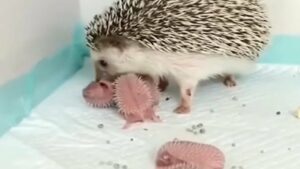Adorable and Amazingly Resilient: Meet the Hoglets
Baby hedgehogs, affectionately known as hoglets, are just about the cutest things. But while they might look like tiny bundles of adorableness, they start life in a surprisingly underdeveloped state. In fact, there’s a lot they’re missing right after birth.
Born Without the Basics
When hoglets enter the world, they can’t see or hear a thing. Their eyes are shut tight, and their ears haven’t even unfolded yet. This means they rely entirely on their mother for survival—from feeding to even helping them with basic bodily functions like going to the bathroom. Despite their limitations, hoglets are surprisingly vocal. They squeak and chirp to let their mom know when they need something.
At birth, they’re only about three inches long and incredibly delicate. In captive environments, handlers avoid touching them for at least two weeks, because any unfamiliar scent on a hoglet could cause the mother to reject or abandon her babies.
And no, those signature hedgehog quills aren’t there yet either—but they don’t take long to appear. Within 24 hours, tiny spikes start to poke through their skin, giving them the first hints of that classic hedgehog look. Around the same time, their skin color begins to shift from bright pink to more muted shades like gray or brown. Their spines are initially black and white, gradually changing as they grow. Within days, they start to sprout some fuzzy hair around their face, making them look like mini versions of their parents.

Early Explorers
Though they’re totally dependent at first, hoglets become curious and mobile pretty quickly. After about six weeks, they begin to explore their surroundings, though they still stick close to mom. By this stage, their spines are well developed, and they’ve learned how to walk and forage for food on their own. They’ve also doubled in size and are well on their way to reaching adult dimensions, which typically happens around the four-month mark. Once fully grown, a hedgehog can have up to 5,000 quills—providing them with plenty of protection in the wild.
Since hedgehogs usually mate in late spring—between May and June—hoglets born during this time have a great window to grow, explore, and get ready for their first hibernation. In just a few short weeks, they go from helpless newborns to fairly self-sufficient little creatures.
Female hedgehogs can have multiple litters a year, but those born earlier in the season, especially in summer, have the best shot at survival. This gives them time to learn critical skills like foraging and nest-building before the colder months roll in.
From helpless pink bundles to independent foragers in just a matter of weeks, hoglets are a perfect example of nature’s incredible design. Their journey from birth to hibernation is nothing short of fascinating—and undeniably adorable.
